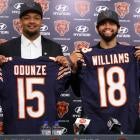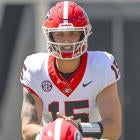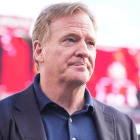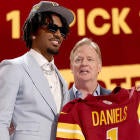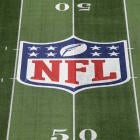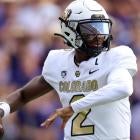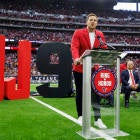That the Chargers are moving to Los Angeles is the least surprising outcome of this offseason. It has been something of a foregone conclusion within that franchise all season, as chronicled here way back in Week 1, and it became a fait accompli at the most recent owner's meetings following a lopsided defeat of the team's measure for funding for a downtown stadium in San Diego.
As cold, hard business decisions go, this was a complete no-brainer. NFL Econ 101. An inevitability by November. The fact the Chargers prefer to play two years at the StubHub Center as a temporary home is also no revelation, as we've widely chronicled their preference to not be in the L.A. Coliseum as the third tenant there and want to be a little further south down the freeway. They also have a plan to expand StubHub to at least 40,000 or so seats to provide an intimate environment -- and hopefully spur demand with a limited supply of seats by NFL standards. All of this has been well chronicled.
The question now becomes whether the NFL's decision to double down on Los Angeles, this most fickle of football markets, will pay off. Color me somewhat skeptical at the onset, with it now official that the Chargers are going to L.A. in 2017, and will be sharing the new stadium in Inglewood with the Rams starting in 2019.
When Wednesday's stadium and finance committee meeting passed without the league extending any sort of financial subsidy or stimulus for owner Dean Spanos to remain in San Diego, as many other owners privately discussed, then it was just a matter of when Spanos would relay the impending move to his employees. That came Thursday morning. Had Spanos requested an extension of his window to move to Los Angeles or asked for a special meeting with the commissioner or extended a Chargers-originated proposal to stay in San Diego, now that would have been the shocker. Had Spanos ignored the reams of economic data indicating the only business decision was to head to L.A., and announced his heart was too tied to San Diego to leave, well, that would have constituted the biggest upset of all.
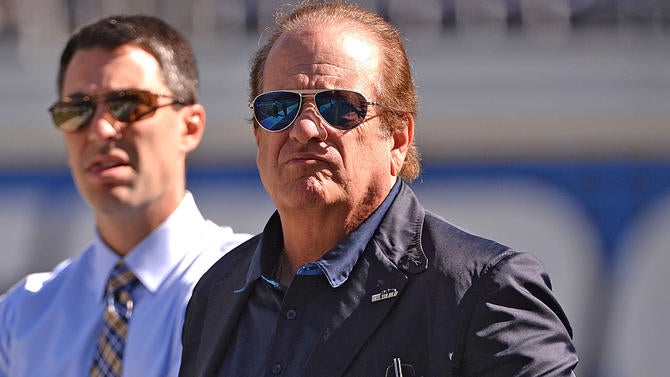
That's not how it works in the big leagues, folks. Certainly not in the NFL. The Raiders left Oakland (and then came back). The Colts left Baltimore -- in the middle of a December snowstorm in Mayflower moving trucks. It's a vision I watched as a child and is forever ingrained in sports lore in my hometown. The Browns left Cleveland for Baltimore and became the Ravens.
The idea that sentimentality would somehow carry the day -- which was largely espoused throughout a portion of the media -- is cute, quaint and naive. Stan Kroenke's stadium in Inglewood was picked over the Carson, Calif. project backed by Spanos, Raiders owner Mark Davis and Disney CEO Bob Iger because of money. Kroenke had the land, he had the deeper pockets and he could essentially self-fund.
The reason the Raiders are on the verge of going to Las Vegas is money. There's essentially $750M in free money to fund that stadium coming from Nevada, along with the $550M in relocation fees to move. And the reason Spanos is leaving San Diego after 56 years for a deal he brokered with the NFL and Kroenke a year ago? Yeah, you guessed it, money.
In fact, the only real surprise in how the run-up to Spanos' decision has played out -- something the Rams have been banking on for months with little internal debate that they were about to share L.A. with the Chargers -- is how these two franchises have handled their rebuilding projects. I braced for an absolute arm's race to get the biggest, boldest coaching staff possible with both clubs searching for a new leader.
While the Rams reached out to Jon Gruden (they were rebuffed) and the Chargers internally discussed the option of trading for Sean Payton, instead neither team is on target to make a splashy coaching hire. Barring a late audible -- and an attempt to land a big fish -- I continue to hear the Rams are most intrigued by 30-year old Redskins offensive coordinator Sean McVay. The Chargers are high on former Falcons coach Mike Smith and Chiefs special teams coach Dave Toub.
Any of those coaches may turn out to be great fits. All merit an opportunity. But in L.A., especially after the Rams effectively wasted 2016 there, none of these moves would generate significant attention, help sell suites or PSLs, or add luster to what has been a largely blasé response to the NFL's return to L.A. And especially in L.A., this ain't just about football and wins and losses. These teams need to move the needle.
I'm no marketing genius, but if I'm the Chargers I am pitching Joey Bosa as West Coast Gronk on every billboard I can find. He's got plenty of that in him, only on the opposite side of the ball. He'd be my latter day Jeff Spicoli in cleats. Hell, I can already see the ticket sales commercials with the new coach as Mr. Hand and Bosa in class with his helmet on, a football in one hand and a surf board in the other. Get the Stones to jam with him on Opening Day. Free pizza for everyone.

Make no mistake, the Rams failed in nearly every way possible in their quest for immediate relevancy in Los Angeles, on and off the field. They were the brunt of jokes from "Hard Knocks" on. They engendered angst and anger with the covert ops involved in their extension of coach Jeff Fisher and GM Les Snead. Ditto for the decision to bench first overall pick Jared Goff much of the season.
If that wasn't bad enough, the Rams fired Fisher in-season to get a jump on all the other teams in the hiring race and let Goff crumble when they did turn the offense over to him. Their offense was consistently wretched to the point Pro Bowl running back Todd Gurley was ineffective and called the Rams' attack a "middle school offense." They turned fans off all season and made the biggest news by publicly sparring with Hall of Fame running back Eric Dickerson. Out-of-town games outdrew Rams games in the local ratings and Silent Stan had basically nothing to say about the untimely turn of events. And, lest anyone forget, the Rams are stuck in the Coliseum for two more seasons.
This is the daunting backdrop as the Chargers enter the market to play in their own temporary digs for two more seasons while coming off their own last-place finish of 5-11. Hey, it's one win better than the Rams! These two teams were a collective 9-23 in 2016. Woo-hoo, L.A.!
My L.A. friends out there -- like Tony Gonzalez and Jim Rome -- have assured me no one is clamoring for a second team , and as much as Kroenke's new stadium surely will be a state-of-the-art thing of beauty and all that, will that be enough to bring people in off the beach if the same two teams are pedestrian at best?
Trust me, I'm not the only one who has these concerns, which is why owners were talking privately about trying to get a proposal to Spanos this week to make him re-think a move to L.A. right now. Going in two years, once that new stadium is built, seemed like a better idea to some. But that's a moot point now. And all these billionaires surely understand Spanos had to do what he had to do, given that many who promised a vote for his Carson project quickly jumped ship during the voting (cajoling?) process at the meeting last January. Just as Davis did what he believed he had to do, which explains why you don't hear any more faux morality chatter out of Park Avenue about being ethically opposed to a franchise in the cradle of U.S. legalized gambling.
So, will it work? I have my druthers. But here is what Spanos is banking on -- besides the fact that he has a quarterback right now and Kroenke doesn't, and his team can at least score some points and play occasionally attractive football, which Kroenke's can't. The Chargers (and the Rams and Raiders and the NFL before them) have pumped millions of dollars over the years into studies of the Los Angeles/Orange County/Inland Empire region and report after report has indicated that for a league this strong, and a market of 20 million or so people, the NFL should be able to have two stable franchises there, just as the MLB and NBA do. The Clippers did sell for $2 billion, with a "B," after all, despite a track record of being nearly irrelevant.
That's what they are banking on.
And this deal with Kroenke protects Spanos from considerable risk should stadium costs go over budget. That's Kroenke's domain, though of course Kroenke can reap more of the rewards as well. The two franchises will be sharing joint revenues but the Chargers are also able to retain much of what they sell on their own. It mitigates much of the risk that would have gone into actually constructing that stadium project in Carson had the NFL allowed it. And the idea of borrowing $500-plus million to fund construction of their own stadium in San Diego, well, that was a non-starter as well.
Yes, Spanos will have to build up more trust with Kroenke -- and vice versa -- and play ball and cooperate. It won't be his vision for the stadium design and construction (and real estate is what the Spanos family does), though Inglewood surely will be a sports and entertainment hot spot almost certain to eventually call combines and drafts and awards shows home. In many ways, Spanos merely will be along for the ride.
But it's a ride with cost certainty and a known end point and erases over a decade of doubt, debate and concern within the family about the long-term future of this franchise. Ultimately, these are decisions that are stripped of emotions. They're made by numbers and dollar signs on a ledger as teams seek to maximize their revenue streams and compete at the highest-level of NFL capitalism. If somehow you didn't see this coming months ago, it's only because you haven't been paying attention. This is how it goes.














